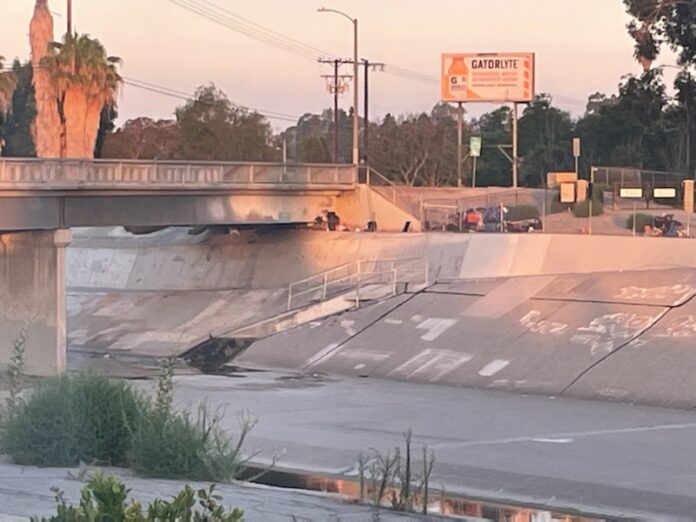While local shelters and additional resources have improved the overall situation of the unhoused in Los Alamitos, Sgt. Chris Lee told the Los Alamitos city council that there are a handful of transients with connections to the city that do seem to linger.
Nevertheless, Lee said in order to truly eradicate homelessness, it’s going to take a deeper approach. His comments came during his recent annual report on the unhoused to the Council.
“These habitual transients are resident transients,” said Lee, adding that “there are a handful of transients who typically have a tie to the city, whether they were displaced from their homes or there is some connection to the city itself.”
In many cases, said Lee, the connection is simply a need for medical services; many come because the city has a major hospital.
“If you think about a homeless population, these people do not have medical (insurance). For medical issues, he said, they have to rely on an emergency room visit.”
“For instance, we have a hospital (in Los Al),” said Lee, and “we also have outreach organizations that are well known within the community (to assist the unhoused). So,” said Lee, “some of the unhoused come to Los Alamitos for services, but they aren’t tied in necessarily to the city itself.”
While there is no dedicated police unit within the department to deal with transients and homeless residents, Lee said he has become Supervisor of an ad-hoc force of himself and four other officers who deal with the problem in Los Alamitos.
“We had two (officers) and just got two more,” he said. He said the department simply puts out a “request for interest” memo among the ranks and accepts officers who volunteer for the duty.
He said the officers who become Homeless Liaison Officers (HLO) volunteer for the extra duty at no additional compensation.
At a minimum, the officers involved take a 40-hour course administered by the Anaheim Police Department to learn the basic techniques and resources available for the unhoused.
Los Al, like other cities in West Orange County, are now a part of the North Special Planning Area (SPA), a coalition of northern OC cities that constructed the Buena Park Navigation Center to provide shelter for the unhoused.
However, officers need to learn the protocols and techniques to approach unhoused persons and transients because he said there is a line between being homeless and a criminal act.
Therefore, Lee said there are many times that officers approach subjects and never even learn their names.
“I know somebody’s going to say, ‘Well, wait a second, how do you guys not know their names?’”
“So, from the police department’s perspective, unless they have committed a crime, we don’t have a legal standing to demand identification,” he said. “So we simply go up, make sure that they’re okay, make sure they’re not committing a crime,” said Lee.
“That’s why about half of our calls for service don’t have a name tied to them,” he said.
Lee said about five percent of the Los Alamitos Police Department’s calls for service are related to transients in some way.
He gave the council an overview on homeless encampments. A homeless camp, said Lee, is a semi-permanent dwelling, where “people have gone in and established some form of shelter. These camps tend to have multiple inhabitants.”
Many times, said Lee, homeless encampments create “an interesting little economy” of its own, with barbeque pits, firepits, and even bicycle repair shops.
Two of the three major camps near Los Alamitos have been cleaned up, Lee noted, and most of the remaining camps are in other jurisdictions. When “cleaning up” the camp, said Lee, officers even are required to catalog all of the possessions found there and give the unhoused a specified period of time to retrieve them.
Because of the procedures imposed by federal judge David O. Carter, police now have to first advise the transients that they are trespassing, give them ample time to plan and even tell them how long it will be before we come back through.
“It’s not…like the bulldozer starts at the top end of the flood control and pushes everything to Seal Beach,” he said.
As of now, said Lee, “we don’t have what I would consider a campsite (in Los Alamitos).”
In Los Al, he said of the handful of unhoused regulars, even they tend to be more transient. Lee said when they do appear, it might be “one person or maybe a couple, with a couple of bedrolls, a backpack and a shopping cart or something like that, and they tend to move along.”
He said there are a handful of regulars, he said, but according to Lee, it’s going to take more than law enforcement to properly deal with root causes of the homelessness issue.
Outgoing Chief of Police Eric R. Nunez said the department still does assist local businesses if business owners find someone sleeping in a hallway or in front of their doors, but “it’s a little bit more difficult to do because of the environment we’re in now.”
Both he and Lee suggested Los Al does receive tremendous cooperation from other law enforcement agencies in the region on this issue.
According to Lee, the homelessness issue will need more than law enforcement to make it go away entirely.
Truth is, said Lee, “there is no way that the Los Al Police Department, or the entire law enforcement community in California can write enough citations to affect the transient issue. It’s just not possible” to do, said Lee.
Long term, Lee said solving the homeless problem is about much more than policing.
“We can enforce the law, we can keep the peace,” Lee said, and “we can do all those things.”
However, to effectively mitigate the homelessness problem, he said it is clear that, “at some point, we will have to address its root causes.”

